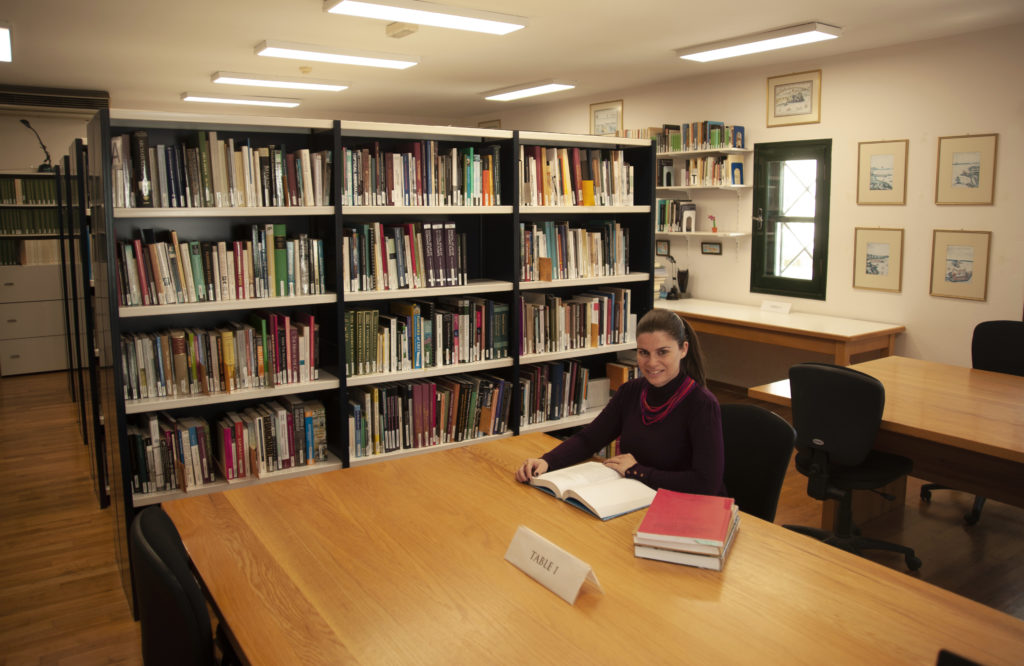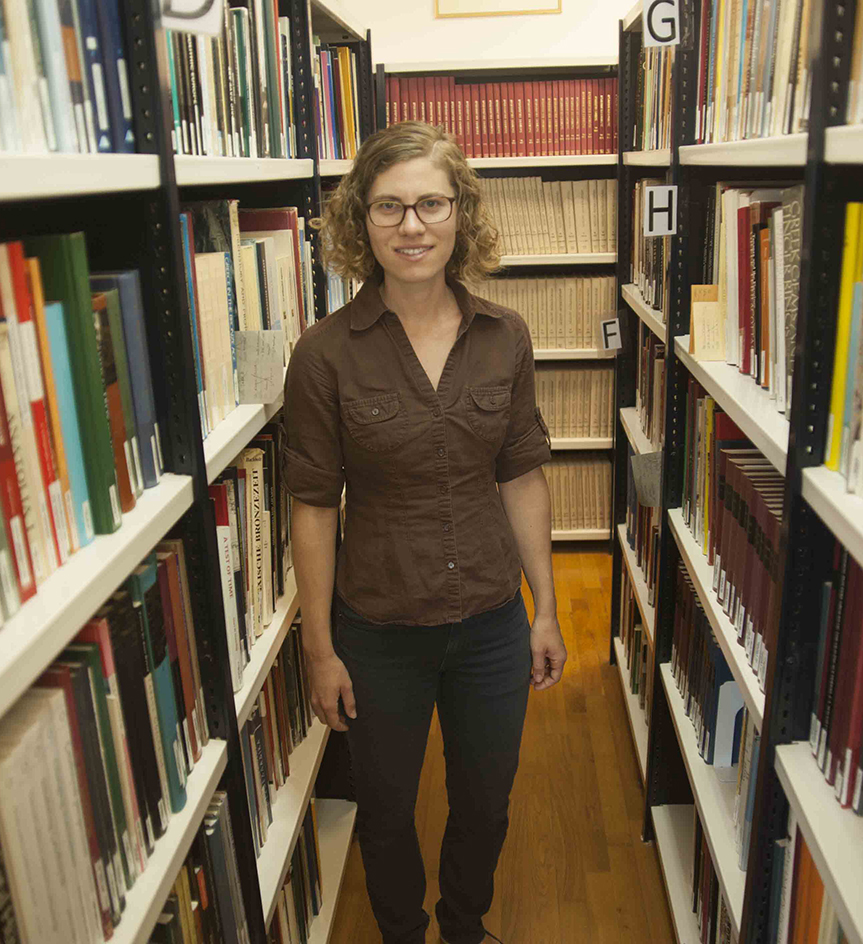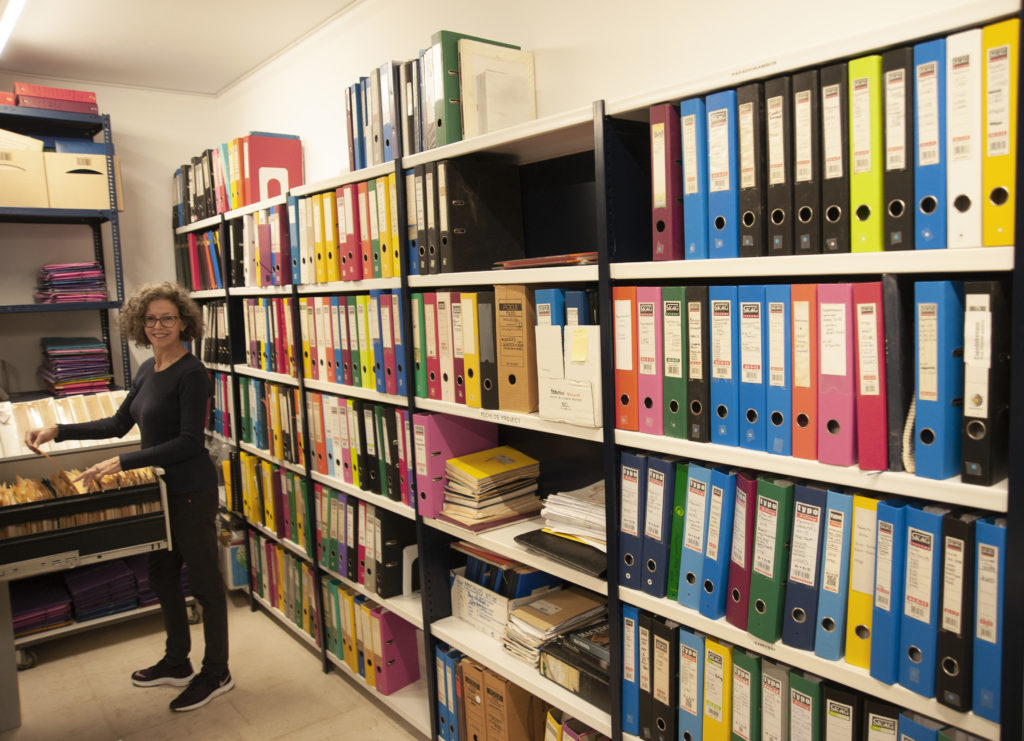About the Library Collection

The library’s collection focuses on all periods of Cretan history and culture with an emphasis on the Aegean Bronze and Iron Ages. By the fall of 2019, the library contained 4,376 books, 4,166 offprints, 111 different periodicals, and 8,850 digital documents (including digitized books, PDFs of articles, dissertations, digital maps, and interactive CDs). In addition to books and periodicals, the collection contains many geological maps of Crete and the surrounding islands. The library’s holdings do not circulate.
The SCEC library catalog is available online. The classification system used is a modified version of the one developed and formerly used by the Blegen Library at the American School of Classical Studies at Athens (ASCSA). Library materials are acquired in one of three ways: purchase, donation, and exchange. The library works with over 20 book and journal exchange partners located throughout Europe. An interlibrary loan system is also in place among the libraries of the Study Center, the University of Rethymnon, and the BSA at Knossos. This makes a much larger number of resources available to the wider community on Crete.
Periodicals and serials housed at the Study Center include:
| Aegean Archaeology: Αρχαιολογία του Αιγαίου Αμάλθεια American Journal of Archaeology Anatolian Studies Annual of the British School at Athens Annuario della Scuola Archeologica di Atene Antiquity Αρχαιολογία Αρχαιολογική Εφημερίς Αρχαιολογικόν Δελτίον Archäologischer Anzeiger Ariadne: Αριάδνη Bulletin de Correspondance Hellénique Bulletin of the American Schools of Oriental Research Corpus der Minoischen und Mykenischen Siegel Cretan Studies Cretica Antica Κρητολογικό Συνέδριο Το Έργον της εν Αθήναις Αρχαιολογικής Εταιρείας Études Crétoises Ευλιμένη. Μεσογειαή Αρχαιολογική Εταιρεία |
Hesperia Hydra Incunabula Graeca Jahrbuch des Deutschen Archäologischen Instituts Journal of the American Institute for Conservation Journal of Field Archaeology Journal of Mediterranean Archaeology Journal of Modern Greek Studies Journal of Prehistoric Religion Kadmos Κρητικά Χρονικά Κρητική Εστία Κρητικό Πανόραμα Κρητικοί Ορίζοντες MASCA Journal Minos Opuscula Atheniensia Πρακτικά της εν Αθήναις Αρχαιολογικής Εταιρείας Studi Micenei ed Egeo Anatolici Studies in Conservation Studies in Mediterranean Archaeology |
History of the Library, Archives, and Fellowship
The history of the INSTAP SCEC library begins before teams started working at the Study Center in 1997. Thomas Brogan and Philip Betancourt purchased numerous books, as well as full and partial runs of periodicals early in 1996, and Philip Betancourt donated a large collection of offprints that still forms the core of this important research tool. Significant gaps were filled by major used-book sellers in North America and Greece. In particular, the Study Center received substantial help from George Theodorou in Athens (Andromeda Books) and the libraries of several foreign schools, which allowed us to make copies of a small number of rare books not widely available for purchase.
For the first seven years of the library’s existence (1997–2004), there was no librarian. During this period, books and offprints were collected and cataloged in a database by Eleanor Huffman. An excellent introduction to managing an archaeological library was provided by Dr. Nancy Winter, then head librarian at ASCSA.
In 2003 Jean Adelman, librarian at the University of Pennsylvania Museum of Archaeology and Anthropology, was invited to evaluate the Study Center library collection and services. Her report was pivotal in helping the Managing Committee to outline the long-term plan for the library. In sum she suggested that the Study Center should focus on a limited collection that addresses the immediate needs of its teams and readers instead of replicating the foreign school libraries in Athens. Because the report coincided with the first publications from INSTAP Academic Press, we were also able to initiate an exchange program with 22 Greek and international archaeological and academic institutions for periodicals and monographs. Finally, she suggested that we consider hiring a part-time librarian.
The Librarian Fellowship was established in 2004. This position, awarded annually, was created to have a full-time librarian manage and develop the collections. Each fellow works mainly in the library, but other projects and tasks are required as well, including archival administration, records digitization, and assisting with photography. Since 2005 the librarian fellowship has been held by Evi Sikla, Eleftheria Daleziou, Yuki Furuya, Melissa Eaby, Vera Klontza-Jaklova, Lily Bonga, Sophia Makri, Stavroula Flouri, Gabriella Lazoura, Rebecca Hahn, Despina Papadopoulou, Niki Saridaki, Vaso Papadopoulou, and Eleftheria Almasidou.

Significant donations and acquisitions have also come from the following sources: Elizabeth Barber, Sabine Beckman, Ellen Davis, Dimitris Papadakis, Angelos Papaioannou, David Rupp, Thomas and Jennifer Shay, Allaire Stallsmith, Ron Stroud, Malcolm Wiener, and the Philip and Mary Betancourt 50th Wedding Anniversary Fund.
In addition to the circulation materials, the library also manages the Archives of the Study Center. The Archives were not part of the original plan of the Study Center, but were installed in the basement in 2007 when it became apparent that additional storage areas would be needed for housing the paper and electronic records from the various excavations and surveys conducted by our member projects (e.g., Azoria, Chrysokamino, Gournia, Hagios Charalambos, Kastro, Mochlos, Petras, Pseira, Vrokastro, and Vronda). The collection includes not only the notebooks and catalogs but also the photographic and drawing collections and the various born-digital analytical records. Beginning in 2008, we also began a long process of digitizing the paper documents so that complete digital records of projects are formed and stored in multiple copies.

Library Contributions
Contributions of books, offprints, and maps relevant to the Aegean are sought, and they will be much appreciated. To make a donation, please contact the librarian.
About the Archives
The Archives of INSTAP SCEC include records of excavations funded or published by INSTAP and administrative records of the Study Center. The excavation records include field and catalog notebooks, reports, photographs, drawings, and plans. Access to excavation records stored in the Archives is only granted with permission from the project director or subsequent director of record. The librarian maintains a searchable PDF to aid in discovery of documents and other analog project records.
Excavation Records in the Archives
Aphrodite’s Kephali
Excavator of record: Vili Apostolakou (2006–2007). Under the auspices of the Hellenic Ministry of Culture, the 24th Ephoreia of Prehistoric and Classical Antiquities. Records include excavation notebooks and catalogs.
Bramiana
Excavator of record: Vili Apostolakou (2011). Under the auspices of the Hellenic Ministry of Culture, the 24th Ephoreia of Prehistoric and Classical Antiquities. Records contain excavation notebooks, reports, and drawings.
Chalasmenos
Excavator of record: Metaxia Tsipopoulou (1992–2008). Under the auspices of the Hellenic Ministry of Culture, the 24th Ephoreia of Prehistoric and Classical Antiquities. Records contain excavation notebooks, registration books, and drawings.
Chryssi
Excavators of record: Vili Apostolakou (2008–2009) and Chrysa Sofianou (2015–2019). Under the auspices of the Hellenic Ministry of Culture, the 24th Ephoreia of Prehistoric and Classical Antiquities. Records contain excavation notebooks, reports, catalogs, registration books, and photos.
Chrysokamino Habitation Site
Excavator of record: Philip Betancourt, in collaboration with Cheryl Floyd (1996–2000). Under the auspices of the American School of Classical Studies at Athens and supported by Temple University. Records contain excavation notebooks, catalogs, reports, and drawings.
Chrysokamino Metallurgy Site
Excavator of record: Philip Betancourt, in collaboration with James Muhly (1996–1997). Under the auspices of the American School of Classical Studies at Athens and supported by Temple University. Records contain excavation notebooks, reports, catalogs, drawings, and photographs.
Damnoni, Mesolithic
Excavator of record: Thomas Strasser and Eleni Panagopoulou (2013). Under the auspices of the American School of Classical Studies at Athens and the Hellenic Ministry of Culture, Paleoanthropological and Speleological Ephoreia. Records contain excavation notebooks, drawings and photographs.
Hagia Photia Settlement
Excavator of record: Metaxia Tsipopoulou (1984–1985). Under the auspices of the Hellenic Ministry of Culture, the 24th Ephoreia of Prehistoric and Classical Antiquities. Records contain catalogs.
Hagios Charalambos Cave
Excavators of record: Philip Betancourt, Costis Davaras, and Eleni Stravopodi (2001–2006). Under the auspices of the American School of Classical Studies at Athens and supported by Temple University. Records contain excavation notebooks, reports, catalogs, and drawings.
Kavousi Kastro
Excavators of record: Geraldine Gesell, Leslie Preston Day, William Coulson (1987–1995). The Kavousi Project was sponsored by the University of Tennessee under the auspices of the American School of Classical Studies in Athens. Records include excavation notebooks, reports, notes, catalogs, drawings, and plans.
Kavousi Vronda
Excavators of record: Geraldine Gesell, Leslie Preston Day, William Coulson (1981–1994). The Kavousi Project was sponsored by the University of Tennessee under the auspices of the American School of Classical Studies in Athens. Records include excavation notebooks, reports, notes, catalogs, drawings, and plans.
Mesorachi
Excavator of record: Chrysa Sofianou (2013–2016). Under the auspices of the Hellenic Ministry of Culture, the 24th Ephoreia of Prehistoric and Classical Antiquities. Records include excavation notebooks, reports, registration books, drawings, and photographs.
Mochlos
Excavators of record: Jeffrey Soles, Costis Davaras (1989–present). Greek-American excavation project conducted under the auspices of the American School of Classical Studies in Athens and the 24th Ephoreia of Prehistoric and Classical Antiquities of the Hellenic Ministry of Culture. Records include excavation notebooks, reports, catalogs, drawings, and photographs.
Pacheia Ammos Alatzomouri Rock Shelter
Excavator of record: Vili Apostolakou (2007). Under the auspices of the Hellenic Ministry of Culture, the 24th Ephoreia of Prehistoric and Classical Antiquities. Records contain excavation notebooks, reports, and catalogs.
Pacheia Ammos Alatzomouri Industrial Area (Pefka)
Excavator of record: Vili Apostolakou (2007–2008). Under the auspices of the Hellenic Ministry of Culture, the 24th Ephoreia of Prehistoric and Classical Antiquities. Records include excavation notebooks, reports, photographs, and catalogs.
Pacheia Ammos Tombs (Alatzomouri)
Excavator of record: Vili Apostolakou (2007). Under the auspices of the Hellenic Ministry of Culture, the 24th Ephoreia of Prehistoric and Classical Antiquities. Records include excavation notebooks, reports, photos, and drawings.
Papadiokampos (including Trachilos)
Excavator of record: Chrysa Sofianou (2007–2012). Under the auspices of the Hellenic Ministry of Culture, the 24th Ephoreia of Prehistoric and Classical Antiquities. Records include excavation notebooks, reports, registration books, drawings, and catalogs.
Pelekita Cave
Excavators of record: Costis Davaras and Athanasia Kanta (intermittently 1979–present). Under the auspices of the Hellenic Ministry of Culture and the Paleoanthropological and Speleological Ephoreia. Records contain excavation notebooks, reports, photos, and drawings.
Petras
Excavator of record: Metaxia Tsipopoulou (1988–present). Under the auspices of the Hellenic Ministry of Culture, the 24th Ephoreia of Prehistoric and Classical Antiquities. Records contain excavation notebooks, registration books, photographs, and drawings.
Pseira
Excavators of record: Philip Betancourt and Costis Davaras (1985–1991). Under the auspices of the Hellenic Ministry of Culture, the 24th Ephoreia of Prehistoric and Classical Antiquities, and the American School of Classical Studies at Athens with support from Temple University. Records contain excavation notebooks, reports, catalogs, drawings, and photographs.
Pseira Shipwreck
Excavator of record: Elpida Hadjidaki (2003–2009). Under the auspices of the Hellenic Ministry of Culture and the Underwater Ephoreia. Records contain pottery catalogs.
Sopata
Excavator of record: Chrysa Sofianou (2016). Under the auspices of the Hellenic Ministry of Culture, Lasithi Ephorate of Antiquities. Records include excavation notebooks, reports, and drawings.
Photograph and Drawing Collections in the Archives
The photographic collection includes photos of objects from 20 sites: Hagios Charalambos (ca. 2,800 photos), Azoria (ca. 7,000 photos), Bramiana (ca. 350 photos), Chryssi (ca. 650 photos), Gournia (ca. 4,000 photos), Chalasmenos (10 photos), Kavousi Kastro (ca. 625 photos), Kavousi Vronda (1 photo), Kephala Vasiliki (ca. 175 photos), Meseleroi (ca. 20 photos), Mesorachi (ca. 475 photos), Mochlos (ca. 5,000 photos), Pacheia Ammos Pefka (ca. 825 photos), Pacheia Ammos Alatzomouri (ca. 625 photos), Papadiokampos (ca. 1,600 photos), Petras (ca. 4,000 photos), Priniatikos Pyrgos (ca. 1,000 photos), Pseira Island (ca. 20 photos), Pseira Shipwreck (ca. 375 photos), Sopata (ca. 25 photos). The drawing collection includes analog and digital records of architecture and artifacts from several sites: Azoria, Chalasmenos, Chrysokamino, Gournia, Kavousi Vronda and Kastro, Mochlos, Papadiokampos, Petras, and Underwater Pseira.
